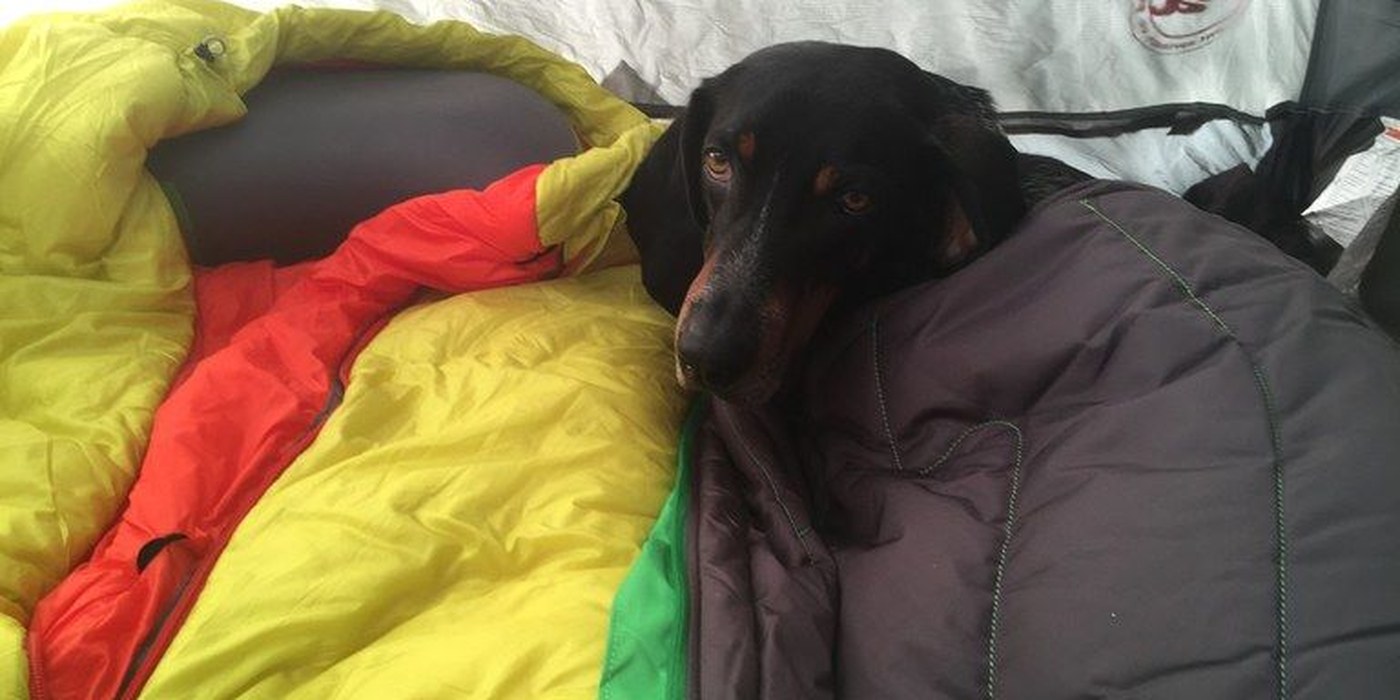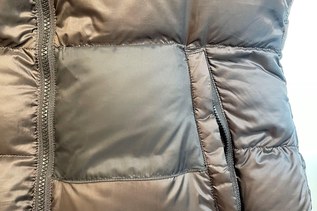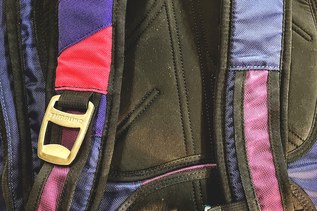 Washington Trails
Association
Washington Trails
Association
Trails for everyone, forever
Gear can be pricey, but it's essential to keeping you warm, safe and dry when you step outside. When it fails, don't replace it; fix it! Get tips on mending holes, re-waterproofing, and learn just how much you can fix before you need to buy new. | By Anna Roth and Kay Sadowitz
Outdoor gear products are marketed to us as weather-proof, dirt-proof, LIFE-proof. While these products are indeed durable, without regular care and cleaning they won’t serve at their peak performance.
And when a piece of gear breaks, it can be frustrating; it's expensive to replace gear!
But gear can be fixed more often than you may realize.
We asked local mender, maker and repairist Kay Sadowitz to outline solutions for common gear damage, including what (and how) you can DIY and when to get a pro's help.
She has years of experience repairing and altering or modifying gear for her clients (WTA staff among them) in order to extend the life of the gear they rely on. One reason she recommends consulting pros:
"A repairist can not only repair your gear, they can answer questions about gear quality or make suggestions to improve your comfort. If a person made it, a person can work with you to fix it!"
Kay (like us) also encourages renting or borrowing gear rather than buying if you're trying something out for the first time. It's a good way to save money and resources.
Here in the Northwest, jackets are a favorite piece of clothing on and off trail, resulting in a fair amount of wear and tear. But other gear can get holes, too! If your favorite waterproof or down item gets a hole in it, you can likely patch it. If a midlayer or wool sweater rips, try your hands at patching (or darning, if you're crafty). Tears or larger holes should be addressed by a repairist.
Down tends to keep you warmer with fewer layers, but is harder to clean. Synthetic can require more layering, but is easier to clean. Dig into the debate between feathers and synthetics in this article. Once you've decided what you need, remember to look for used items rather than buying new!
 Down (left) or synthetic (right) sleeping bags can both serve — it just depends on your personal temperature. Photo by Vickie Wallace.
Down (left) or synthetic (right) sleeping bags can both serve — it just depends on your personal temperature. Photo by Vickie Wallace.
Waterproof garments are made by sealing together several very thin layers of material. The combination of frequent use and exposure to sweat, dirt, body oils, sunscreen or bug spray can cause those layers to separate or cause the waterproof seam tape to peel.
Prevent this deterioration by washing these garments with the correct cleaner (like Nikwax or Gear Aid) and reapplying the durable water repellancy (DWR) once a season. The special wash and DWR may seem pricey, but it’s better for your wallet and the environment than buying a new rain jacket every year! Still looking for that perfect rain jacket? Let us help you find one.
Before you get started, don't use regular laundry detergent! It has chemicals in it that can cause further damage to the fabric.
If you tear a hole in a waterproof jacket or a seam separates, a repairist can sew a patch or stitch seams as well as add waterproof seam tape. See the section above for mending holes and tears.

Having good rain gear is crucial for fun on a work party or on a hike! Photo by Joshua Orendorf.
As ducks and geese know, feathers need to be cleaned regularly in order to function properly. The warmth in down comes from the spaces (called loft) between the feathery tendrils, which hold heat in small air pockets. Loft helps birds stay warm and dry in the freezing cold, and it lets you stay warm in your favorite down item.
So how do you channel this avian magic? By cleaning it, a lot more than you probably think you need to.
A sleeping bag should be washed about once a season if you backpack regularly (about 2x a month) because the down gets dirty, sweaty or wet from condensation, and that causes the down tendrils to get soiled and limp. Yick.
The down side of down items is that they are thin and prone to melting when exposed to heat. Drying in a commercial dryer is best, but can be time-consuming at the proper temperature.
Kay recommends going to a repairist if you're washing a sleeping bag: "The big dryer drum is what is really necessary to get sleeping bags nice and lofted." And if you have the space, store your sleeping bag loose. Long term compression can cause down to deteriorate quickly.
If you have a fair amount of spare time and you’re feeling ambitious, you can wash your down gear (like jackets or vests) yourself.
 Trail Smarts: Keep it clean, let it breathe
Trail Smarts: Keep it clean, let it breathe
— Cleaning and storing your gear properly is important to ensuring it performs as long as you need it to.
— Here are some products we rely on to get our gear in good shape each year.
— Tips and equipment you may want to adopt to keep your camp extra clean this season
Should you get leather boots that fit to your feet? Mesh trail runners to let them breathe? Zero-drop? A high ankle boot? Finding the perfect shoe can take a while, so once you do, you'll want to keep them in great shape. There's likely no need to get rid of them just because of some small damage.
Contrary to popular belief, zippers can be repaired (sometimes)! But you should almost always consult a repairist if you need a zipper fix. There are tons of brands, models, shapes and sizes of zippers, and finding the right match can be time-consuming or confusing. Forcing the wrong slider onto a zipper can cause it to fail faster, and trying to repair something using glue is going to make a huge mess.
The kind of damage can determine what kind of repair you will need.
You may need a new slider (the part that slides and connects the two sides of the zipper together). The mechanism inside it can wear out over time.
A new slider may help, but you will likely need a zipper replacement now or very soon.
A full replacement is necessary.
Bring it to a repairist and they can help you troubleshoot. A new zipper is a worthwhile fix on a good garment and can help it last for years

Common zipper problems include: A zipper that occasionally comes apart; fraying fabric around the zipper or broken teeth; wear and tear on the box and pin. Photos courtesy Kay Sadowitz.
There’s one zipper fix you can do at home; if your zipper looks to be in good shape overall but is a bit sticky, try a zipper lubricant or cleaner. This is especially useful on tents.
How to: Goop a little bit of the lubricant on the zipper and brush it in with a toothbrush all along the zipper. This will help dislodge debris. Run the sliders through the zipper and lubricant a couple times, then use a clean rag to wipe off the excess goop along the entire zipper. If this doesn't work and your zipper is still crunchy, bring it to a repairist to help you with other options.
 Backpacks
BackpacksWith zippers and straps, there are a couple of ways things can go sideways in the backcountry. You can reattach a broken strap with some dental floss and a needle (being cautious about poking your fingers!)
If your zipper separates from the fabric, safety pins will help you keep it closed. Of course, be sure to have a sewist fix damage like that once you’re back home (see photo to the right).
One of Kay's favorite backpack hacks is to replace your shoulder straps (see photo). You can do this if you need a different fit, or if the original straps fail entirely. "It's a great repair, and REI often sells just straps on their outlet or Re/Supply. People can also get a pack at a thrift store and salvage the straps off of it."
First off, keep them clean!
If you find your tent seam tape peeling throughout the tent, the fabric of your tent getting sticky, stinky, flaky or paper thin, or despite your re-proofing efforts it is still not waterproof, you may have only a few adventures left in it. A repairist may be able to use fabric from an old tent in other repairs.
A bent pole or a loose shock cord (the bungee cord that runs through a tent pole) can make pitching your tent a headache. Here’s how to deal with those issues.
For damage beyond loose shock cords, consult a repairist. It's a good idea to take care of this as soon as you get home, since broken tent poles can really mess up a backpacking trip!
There’s nothing worse when camping than waking up on the cold ground because of a hole in your sleeping pad. Luckily, they’re relatively easy to fix!
If you determine the sleeping pad is totally busted, the material can be used by someone crafty. see if a creative reuse store or repairist can use it; it's great, durable fabric.
Outdoor gear is meant to be heavily-used out in an unpredictable environment, so if you rip, tear, bust or break your gear, it just means you're using it right! Keep it going for years with good maintenance. Kay also mentions that GORE has a lifetime warranty on any product with GORE in it (think GORE-Tex). Contact them directly for the warranty process.
Ultimately, there are times that something is just not repairable anymore, and that’s OK, it just means you’ve been using your gear for what it’s made for! There are a few possibilities for your totally worn out stuff.